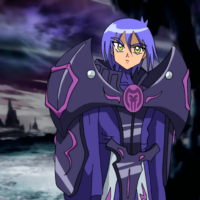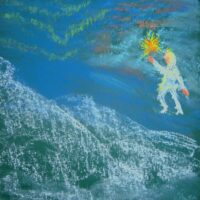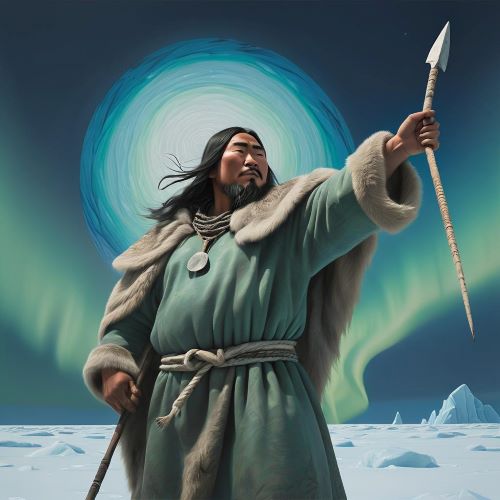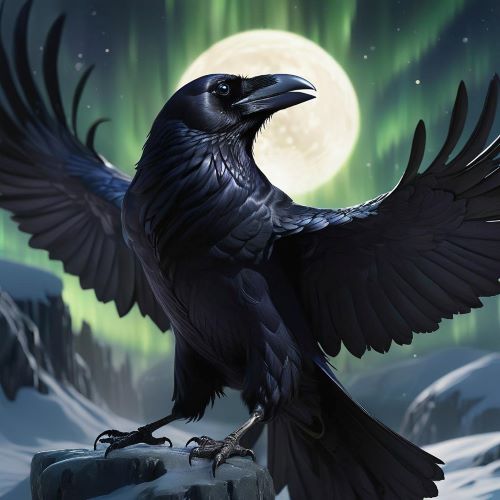Akycha : The Solar Deity
Listen
At a glance
| Description | |
|---|---|
| Origin | Inuit Mythology |
| Classification | Gods |
| Family Members | N/A |
| Region | Alaska |
| Associated With | Sun, Life |
Akycha
Introduction
Akycha, a figure of great respect in Inuit mythology, is particularly venerated among the Inuit population of Alaska. As a solar deity, she symbolizes the sun’s life-sustaining power. In the intricate world of Inuit mythology, Akycha is a compelling entity, representing the elemental force of the wind. She is esteemed within the Inuit culture for her dominion over nature, epitomizing both the soft breeze and the intense Arctic gales. Akycha, the luminous sun goddess, occupies a crucial position in the rich narrative of Alaskan Inuit mythology. Her existence encapsulates the sun’s warmth, light, and the vital essence of the severe Arctic climate. Contrary to the common depiction of sun deities as male, Akycha distinguishes herself as a potent female character, underscoring the unique viewpoint of the Inuit people.
Physical Traits
Akycha, a solar deity in Inuit mythology, is often portrayed as a luminous entity, symbolizing the sun’s warmth and light. However, Inuit mythology typically emphasizes the spiritual and symbolic aspects of their deities, rather than specific physical traits. Akycha is frequently represented as an elegant and celestial being, embodying the wind’s fluidity and unpredictability. Visual depictions often show her with hair that appears to merge with the surrounding air, as if swept by the wind. Her eyes are thought to be as transparent and variable as the sky, reflecting the atmospheric conditions.
Akycha’s form is elusive, often materializing as a transient figure on the horizon, encapsulating the wind’s elusive nature. Regrettably, detailed accounts of Akycha’s physical appearance are sparse in existing records of Inuit mythology. The stark realities of Arctic survival often prioritized the role and power of a deity over physical details. Nonetheless, based on her connection with the sun, we can deduce certain attributes. Akycha might be imagined as a glowing entity, possibly embellished with golden tones or graced with a radiant halo symbolizing the sun’s brilliance.
Family
Akycha is often perceived as an independent entity, more closely linked to the natural elements than to familial relationships. Yet, some interpretations propose that she may be a companion to other spirits or gods within the pantheon, representing various elements. As a wind deity, Akycha’s affiliations are more rooted in the natural world than in traditional family ties. The Inuit pantheon is multifaceted and exhibits slight variations depending on the specific region of the Inuit people. While Akycha’s direct familial connections are not explicitly detailed in the mythology, she is part of the pantheon alongside other notable deities such as Aakuluujjusi, the revered creator mother, and Alignak, the god of the moon, storms, earthquakes, and tides.
The Inuit pantheon is intricate and its composition depends on the specific regional and cultural customs. While details about Akycha’s immediate family are scarce, some researchers suggest she might have a connection to Aakuluujjusi, the esteemed creator mother in Inuit belief. This connection would reinforce Akycha’s role as a crucial entity within the cosmos, tasked with the responsibility of sustaining life in conjunction with the earth mother.
Other names
Akycha is predominantly recognized by this moniker among the Inuit populace of Alaska. There are no documented alternate appellations for Akycha, possibly due to the regional specificity of her veneration. The Inuit language, with its wide array of dialects spoken across diverse regions, reflects this diversity in the potential alternative names for Akycha. Some sources cite “Qayaq” (translating to “kayak”), possibly alluding to the crucial role of sunlight in navigating the icy waters.
Another possible name is “Angutahiinnaq,” translating to “His/Her Father’s Wife,” which might suggest a linkage to a superior male deity. In various Inuit communities, Akycha is known by distinct names, each mirroring subtle facets of her character and influence. In certain regions, she is referred to as “Nuliajuk,” associating her with the sea and the icy depths. In other narratives, she is known as “Aulanerk,” underscoring her role as an agent of change and transformation through the winds.
Powers and Abilities
Akycha, wields control over the wind, shaping weather patterns and seasons across the icy expanses of the tundra. Her reach is not limited to physical phenomena; she is also thought to have the ability to transmit messages over great distances, linking remote communities through the wind’s whispers. Akycha embodies both the gentle breeze that brings comfort and the storm that tests resilience.
Her primary authority is over the sun, controlling the cycle of day and night, and determining the duration of daylight that is vital for hunting and fishing activities. Her radiant warmth initiates the thawing season, briefly rendering the land fertile. Some narratives suggest that Akycha can also manipulate the weather, summoning sunshine or triggering storms as per the requirements of her people. The sun’s life-sustaining attributes are intrinsically linked with Akycha’s being. She is revered as a guardian and benefactor, safeguarding the welfare of the Inuit community. Some tales even propose that her influence transcends the physical world, guiding souls in the afterlife.
The Arctic’s severe environment instills a profound reverence for nature and its divine guardians. Although there are no extensive records of specific rituals dedicated to Akycha, it is plausible that offerings and festivities were held during periods of prolonged sunlight. Expressions of gratitude to the sun goddess might have included songs, dances, and possibly the burning of special oils or animal fats.
Modern Day Influence
Akycha’s enduring influence is seen in the ongoing reverence for nature among the Inuit today. The sun, representing life and sustenance, frequently appears in Inuit art and stories, symbolizing Akycha’s enduring cultural importance. As our knowledge of Inuit mythology and its diverse deities expands, Akycha’s role as a solar deity underscores the sun’s vital significance in our daily lives.
Her legacy resonates within the Inuit community, often depicted in modern art as a radiant woman or sun symbol. The focus on environmental preservation and Arctic ecosystem balance reflects Akycha’s embodied significance. Additionally, Akycha serves as a potent symbol of feminine power and leadership in Inuit culture, challenging conventional gender roles and highlighting women’s importance.
Akycha’s spirit echoes in contemporary culture, adapted in Inuit art alongside other elemental beings. Modern literature and film draw from Inuit mythology, introducing characters akin to Akycha whose stories reflect humanity’s eternal struggle with nature. Recently, there’s been a surge in interest to preserve and share Inuit mythology, ensuring deities like Akycha remain part of collective awareness. Cultural initiatives and educational programs celebrate and honor Inuit legends, preserving Akycha’s spirit for future generations.
Related Images
Frequently Asked Questions
What is lorem Ipsum?
I am text block. Click edit button to change this text. Lorem ipsum dolor sit amet, consectetur adipiscing elit. Ut elit tellus, luctus nec ullamcorper mattis, pulvinar dapibus leo.
What is lorem Ipsum?
I am text block. Click edit button to change this text. Lorem ipsum dolor sit amet, consectetur adipiscing elit. Ut elit tellus, luctus nec ullamcorper mattis, pulvinar dapibus leo.
What is lorem Ipsum?
I am text block. Click edit button to change this text. Lorem ipsum dolor sit amet, consectetur adipiscing elit. Ut elit tellus, luctus nec ullamcorper mattis, pulvinar dapibus leo.
What is lorem Ipsum?
I am text block. Click edit button to change this text. Lorem ipsum dolor sit amet, consectetur adipiscing elit. Ut elit tellus, luctus nec ullamcorper mattis, pulvinar dapibus leo.
What is lorem Ipsum?
I am text block. Click edit button to change this text. Lorem ipsum dolor sit amet, consectetur adipiscing elit. Ut elit tellus, luctus nec ullamcorper mattis, pulvinar dapibus leo.










